Who Let the Jigs Out?
Joe Rummelt of Laketown - that's who
Some
say a dog is man's best friend or diamonds are a girl's
best friend. I say jigheads are my best friend. Here's a review a
few of my most productive soft plastic jig combinations featuring
Laketown jig and Yamamoto soft plastic combos.
Weedless Hula Grub Jig
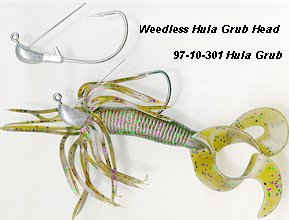 There are over 136 models and sizes of
Laketowns; all made exclusively with Gamakatsu jig hooks. On open
bottom, I like the productivity of the Hula
Grub Jig so much that I asked Laketown to make a weedless
model with a two-prong wireguard for sparse cover and rocks. The
wide flat head tends to stand up on bottom, which is key to keep
it snagless when slow-crawling crawdad-imitating baits. If
it does tip over, the spread wireguard still helps deflect snags
off both sides of the hook point. There are over 136 models and sizes of
Laketowns; all made exclusively with Gamakatsu jig hooks. On open
bottom, I like the productivity of the Hula
Grub Jig so much that I asked Laketown to make a weedless
model with a two-prong wireguard for sparse cover and rocks. The
wide flat head tends to stand up on bottom, which is key to keep
it snagless when slow-crawling crawdad-imitating baits. If
it does tip over, the spread wireguard still helps deflect snags
off both sides of the hook point.
The 4/0 60° EWG hook is super for the 99-series
and 97-series double tail hula grubs on
medium/heavy gear with line over 12 to 16 lb test. The jumbo
99-series will take a better grade of bass. I am not aware of
another company, only Yamamoto that makes a jumbo size hula grub.
This jig can also be gotten with a smaller 3/0 90° hook. It
matches with the small profile 3S-series
Baby Crawdad and the smallest 93-series
double tail hula grub on medium tackle below 12 to 8 lb test.
This hypodermic-sharp 3/0 Gamakatsu hook will set easily when a
bass bites it, even on light line with a wireguard.
Weedless Grub Jig
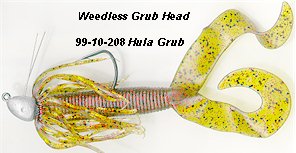 In thick weeds and brush, the pointy nose
of the streamlined Weedless
Grub Jig slips in and out of dense cover better than the wide
flat head of the Hula Grub Jig above. Fan the wireguard far out
to the sides so that it guards the hook from snags all around
rather than just in front. In thick weeds and brush, the pointy nose
of the streamlined Weedless
Grub Jig slips in and out of dense cover better than the wide
flat head of the Hula Grub Jig above. Fan the wireguard far out
to the sides so that it guards the hook from snags all around
rather than just in front.
I'll still use the 99-series
and 97-series double tail hula grubs with the 4/0
60° EWG hook, except use it more like a dropbait right in the
thickest part of the cover with heavy fishing line.
With thinner line and medium tackle, again I opt for the 3/0
90° hook using pint-sized 3S-series
crawdads and small 40-series
single tail grub on lightweight 1/8 or 3/16 oz heads. If you
learn to master the skill of setting the hook properly, the
wireguard will not cause you to lose fish - even on line as light
as 8 lb test. Here's how.
As the grub swims along, a fish may pick it up and keep
moving towards you and off to one side. Just continue to reel in
deliberately and at the same time move the rod tip down and
extend your rod arm down in front of you. It is definitely not
good to let the line go slack or come too tight when you do this.
It is usually okay if you find that you are putting slightly
extra steady tension on the line. This all needs to happen in the
space of a few seconds, Then start to bring your rod up towards
your shoulder as you reel faster and sweep the rod tip back
overhead. This stretches the line and starts to pull the jig out
of the fish's mouth. At that instant, the fish will clamp down
hard on the bait, depress the wireguard and help the hook point
stick in a spot. When the fish makes its initial run against a
tight line, you must follow through with a couple of short tugs
to set the hook into the fish's mouth past the barb.
 If you do not get a pick-up as the grub
swims along, just wait until it bumps into anything in its
path, including weeds, rocks or wood. The streamlined shape of
the head and the wireguard make this lure highly snag-resistant.
When it hits something, snap the jig crisply to excite any fish
that may be nearby and also to shake off any debris that it may
have picked up on impact. Key to keep it snagless is that there
is no crevice where weeds can lodge between the eye of the hook
and the nose of the jig. If it feels like something has fouled
the bait, keep snapping the rod tip sharply until the grub feels
clean as it falls. Let the lure flutter down to the bottom and
lie there. If you snapped the rod tip right, the line will be
floating high and loose on the surface and you will be holding
the rod tip at two o'clock. Just squint at the line intently
where it enters the water and anticipate that at any moment the
line is going to jump and then streak across the surface as a
bass picks up your offering and runs off with it. This is the
most intense moment in fishing. A bass is hustling off with your
bait yet you must hold back and lower your rod tip down to the
water. As the fish starts to pull the line tight, set the hook as
described in the preceding paragraph. Follow through with a few
tugs to pull the barb home as the fish runs. If you do not get a pick-up as the grub
swims along, just wait until it bumps into anything in its
path, including weeds, rocks or wood. The streamlined shape of
the head and the wireguard make this lure highly snag-resistant.
When it hits something, snap the jig crisply to excite any fish
that may be nearby and also to shake off any debris that it may
have picked up on impact. Key to keep it snagless is that there
is no crevice where weeds can lodge between the eye of the hook
and the nose of the jig. If it feels like something has fouled
the bait, keep snapping the rod tip sharply until the grub feels
clean as it falls. Let the lure flutter down to the bottom and
lie there. If you snapped the rod tip right, the line will be
floating high and loose on the surface and you will be holding
the rod tip at two o'clock. Just squint at the line intently
where it enters the water and anticipate that at any moment the
line is going to jump and then streak across the surface as a
bass picks up your offering and runs off with it. This is the
most intense moment in fishing. A bass is hustling off with your
bait yet you must hold back and lower your rod tip down to the
water. As the fish starts to pull the line tight, set the hook as
described in the preceding paragraph. Follow through with a few
tugs to pull the barb home as the fish runs.
If you do not get a pick-up while line-watching, then shake
n' bake next. Raise the rod tip high enough overhead to bring
all the floating line up off the surface of the water and into
mid-air except where the line enters into the water. Now reel in
excess slack so that when you lower the rod tip back to about two
o'clock there is a loose belly in the line. Start to shake the
rod tip fast from noon to two o'clock. Shake up and shake down.
Faster. You need to have that little slack belly of the line
rapidly oscillating up and down, cutting an arc in mid-air. The
jig should not move forward along the bottom when you do this.
Really shake it up good for five or more seconds. Then stop
shaking and let the line fall to float loosely on the surface
again. This is the "bake" part - and also when to
expect to get bit! You should repeat the shake n' bake sequence
several times before moving the jig forward. When you are finally
ready to crawl the jig forward, do so only after letting the lure
bake for a long while. Often fish will just sit motionless and
watch the grub shake n' bake in front of them for a long time
before inhaling it. If you move the grub through the fish's
location too fast, they usually do not follow it and may even
move away.
Stand Up Jig
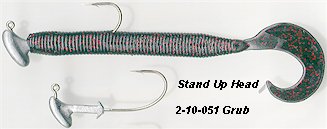 As an angler, there's nothing special I can
see about the 2-series single tail grub, except I notice
that bass can be terribly fond of it. I particularly like to fish
it on an open hook Stand
Up Jig. I tend to keep an open hook jig moving more quickly
than a wireguard jig. I use a stiff rod and whenever the Stand Up
jig hits bottom debris, I'll instantly snap the rod tip to jig it
up and over the debris, which can be rocks, weeds, brush or wood.
As the jig recovers its composure from being shocked over the
debris, I'll get a reaction bite right then. I call this snap-jigging.
It's cool. I use the open hook Stand Up Jig to do it. As an angler, there's nothing special I can
see about the 2-series single tail grub, except I notice
that bass can be terribly fond of it. I particularly like to fish
it on an open hook Stand
Up Jig. I tend to keep an open hook jig moving more quickly
than a wireguard jig. I use a stiff rod and whenever the Stand Up
jig hits bottom debris, I'll instantly snap the rod tip to jig it
up and over the debris, which can be rocks, weeds, brush or wood.
As the jig recovers its composure from being shocked over the
debris, I'll get a reaction bite right then. I call this snap-jigging.
It's cool. I use the open hook Stand Up Jig to do it.
Bullet Jig
 The Bullet
Jig wins best of show when it is darting barely above ledges
and cracks where bass hide, darting through the upper crowns of
flooded brush and over laydown logs, using soft plastic jerkbaits
like the 9J-series and 9S-series
Senko and the 7L-series Cut Tail. The Bullet
Jig wins best of show when it is darting barely above ledges
and cracks where bass hide, darting through the upper crowns of
flooded brush and over laydown logs, using soft plastic jerkbaits
like the 9J-series and 9S-series
Senko and the 7L-series Cut Tail.
In shallow water around visible cover, keep the rod tip
at ten o'clock and reel in slow and straight. Flick the wrist to
produce an alluring dart and hesitation every so often. As the
jerkbait clears the outside edge of ledges, cracks, rocks, weeds,
brush or laydowns, quickly flick the rod tip to make the lure
dart and hesitate. Then abruptly drop the rod tip to mend some
slack into the line so the jerkbait spirals down toward bottom.
If you haven't gotten bit yet, catch it just before it falls all
the way. If you let the open hook jig hit bottom near shallow
cover, you'll risk snagging it.
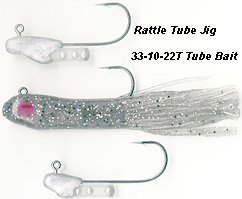 Above deep structure or over suspended
bass, begin with long casts that let the darter jig pendulum
swing down through the water column on a long horizontally-arcing
fall. If there is a bottom contour, you'll want the pendulum fall
of the darter jig to loosely follow it down to deeper water. That
will usually work, and a bite is often signaled by the line
suddenly becoming quite slack, slowing down, or moving off faster
than before. But if that doesn't work, go the other way - from
deep to shallow. Get right over the high spot on the point or on
top of the ledge shelf, but cast towards the deep side and let
the jig pendulum into you, keeping it barely touching bottom
until it is right under the boat. This is a minnow imitation
here. It is a long fluid baitfish that darts down to reach the
shady safety of the bottom, trying to get under the shelf only to
get hammered by a watchful bass that rises up off bottom to
engulf it. Above deep structure or over suspended
bass, begin with long casts that let the darter jig pendulum
swing down through the water column on a long horizontally-arcing
fall. If there is a bottom contour, you'll want the pendulum fall
of the darter jig to loosely follow it down to deeper water. That
will usually work, and a bite is often signaled by the line
suddenly becoming quite slack, slowing down, or moving off faster
than before. But if that doesn't work, go the other way - from
deep to shallow. Get right over the high spot on the point or on
top of the ledge shelf, but cast towards the deep side and let
the jig pendulum into you, keeping it barely touching bottom
until it is right under the boat. This is a minnow imitation
here. It is a long fluid baitfish that darts down to reach the
shady safety of the bottom, trying to get under the shelf only to
get hammered by a watchful bass that rises up off bottom to
engulf it.
90° Rattle Tube Jig
This model highlights a baitfish-shaped head inside the 33-series
tube bait, and it has a pronounced rattle. On several occasions,
I do notice this rattling model to produce a few more bites than
its non-rattling counterparts, Not always, but often enough that
I always will try it and see if it makes a difference. Sometimes
it does.
Pro Model Tapered Tube Jig
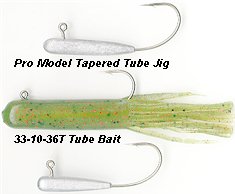 Tube jigs have always caught bass and
always will. If you aren't adept with tube jigs, you are missing
out. Laketown makes more models of tube jigs than you can easily
count, but the Pro Model
Tapered Tube Jig from 1/16 to 3/8 oz with regular Gamakatsu
hooks is one of my most productive. There are actually two
models with the same name, Pro Model Tapered Tube Jig (one
regular sizes, one heavy sizes) and I use both in the 33-series
tube bait. Tube jigs have always caught bass and
always will. If you aren't adept with tube jigs, you are missing
out. Laketown makes more models of tube jigs than you can easily
count, but the Pro Model
Tapered Tube Jig from 1/16 to 3/8 oz with regular Gamakatsu
hooks is one of my most productive. There are actually two
models with the same name, Pro Model Tapered Tube Jig (one
regular sizes, one heavy sizes) and I use both in the 33-series
tube bait.
A Trio of Heavy Tube Jigs
There is also another heavier model of Pro
Model Tapered Tube Jig from 1/2 to 1 oz with heavy wire
Gamakatsu hooks; also Laketown's Heavy
Tube Jig and Heavy
Rattling Tube Jig up to one ounce. I have details about
this trio of heavy tube jigs in another article, One Ton Torpedo Tubing.
I'd say them's some of my personal best friends above. I am
sure there are several more good jigheads waiting for you to
befriend them...at Laketown.
| 